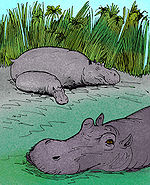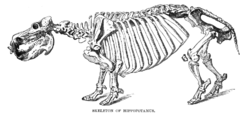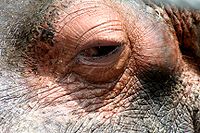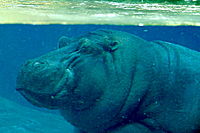
Hippopotamus
Background to the schools Wikipedia
The articles in this Schools selection have been arranged by curriculum topic thanks to SOS Children volunteers. With SOS Children you can choose to sponsor children in over a hundred countries
| Hippopotamus | |
|---|---|
 |
|
| Pod of hippos, Luangwa Valley, Zambia | |
| Conservation status | |
|
Vulnerable ( IUCN 3.1) |
|
| Scientific classification | |
| Kingdom: | Animalia |
| Phylum: | Chordata |
| Class: | Mammalia |
| Superorder: | Cetartiodactyla |
| Order: | Artiodactyla |
| Family: | Hippopotamidae |
| Genus: | Hippopotamus |
| Species: | H. amphibius |
| Binomial name | |
| Hippopotamus amphibius Linnaeus, 1758 |
|
 |
|
| Range map | |
The hippopotamus (Hippopotamus amphibius), from the Greek ἱπποπόταμος (hippopotamos, ιππος hippos meaning "horse" and πόταμος potamus meaning "river"), often shortened to "hippo", is a large, mostly plant-eating African mammal, one of only two extant species in the family Hippopotamidae (the other being the Pygmy Hippopotamus).
The hippopotamus is semi-aquatic, inhabiting rivers and lakes in sub-Saharan Africa in groups of 5-30 hippos. During the day they remain cool by staying in the water or mud; reproduction and childbirth both occur in water, where territorial bulls preside over a stretch of river. They emerge at dusk to graze on grass. While hippos rest near each other in territories in the water, grazing is a solitary activity and hippos are not territorial on land.
Despite their physical resemblance to pigs and other terrestrial even-toed ungulates, their closest living relatives are cetaceans (whales, porpoise, etc.). The common ancestor of whales and hippos split from other even-toed ungulates around 60 million years ago. The earliest known hippopotamus fossils, belonging to the genus Kenyapotamus in Africa, date to around 16 million years ago.
The hippopotamus is recognizable for its barrel-shaped torso, enormous mouth and teeth, hairless body, stubby legs and tremendous size. It is similar in size to the White Rhinoceros; only elephants are consistently heavier. Despite its stocky shape and short legs, it can easily outrun a human. Hippos have been clocked at 30 mph (48 km/h) while running short distances, faster than an Olympic sprinter. The hippopotamus is regarded to be Africa's most dangerous animal, and is among the most aggressive animals in the world. There are an estimated 125,000 to 150,000 hippos remaining throughout Sub-Saharan Africa, of which Zambia (40,000) and Tanzania (20,000-30,000) have the largest populations . They are still threatened by poaching for their meat and ivory canine teeth, and by habitat loss.
Taxonomy and origins
Hippopotamuses ( plural hippopotami is also used ; hippos can be used as a short plural) are gregarious, living in groups of up to 40 animals; such a group is called a pod, herd, dale, or bloat. A male hippopotamus is known as a bull, a female as a cow, and a baby as a calf. They are also known as the Common Hippopotamus or the Nile Hippopotamus.
The hippopotamus is the type genus of the family Hippopotamidae. The Pygmy Hippopotamus belongs to a different genus in Hippopotamidae, either Choeropsis or Hexaprotodon. Hippopotamidae are sometimes known as Hippopotamids. Sometimes the sub-family Hippopotaminae is used. Further, some taxonomists group hippopotamuses and anthracotheres in the super-family Anthracotheroidea or Hippopotamoidea.
Five subspecies of hippos have been described based on morphological differences in their skulls and geographical differences:
- H. a. amphibius – (the nominate subspecies) which stretched from Egypt, where they are now extinct down the Nile River to Tanzania and Mozambique.
- H. a. kiboko – in the Horn of Africa, in Kenya and Somalia. Kiboko is the Swahili word for hippo. Broader nasals and more hollowed interorbital region.
- H. a. capensis – from Zambia to South Africa. Most flattened skull of the subspecies.
- H. a. tschadensis – throughout Western Africa to, as the name suggests, Chad. Slightly shorter and wider face, with prominent orbits.
- H. a. constrictus – in Angola, the southern Democratic Republic of Congo and Namibia. Named for its deeper preorbital constriction.
The suggested subspecies were never widely used or validated by field biologists; the described morphological differences were small enough that they could have resulted from simple variation in non-representative samples. Genetic analyses have tested the existence of three of these putative subspecies. A study examining mitochondrial DNA from skin biopsies taken from 13 sampling locations, considered genetic diversity and structure among hippo populations across the continent. The authors found low but significant genetic differentiation among H. a. amphibius, H. a. capensis, and H. a. kiboko. Neither H.a.constrictus nor H.a.tschadensis have been tested.
Classification
Hippopotamidae are classified along with other even-toed ungulates in the order, Artiodactyla. Other members of Artiodactyla include camels, cows, deer and pigs; although hippopotamuses are not closely related to these species.
As indicated by the name, ancient Greeks considered the hippopotamus to be related to the horse. Until 1985, naturalists grouped hippos with pigs, based on molar patterns. Evidence, first from blood proteins, then from molecular systematics and DNA and the fossil record, show that their closest living relatives are cetaceans—whales, porpoises and the like. Hippopotamuses have more in common with whales than they do with other Artiodactyls (even-toed ungulates), such as pigs, because the common ancestor of hippos and whales branched-off from ruminants and the rest of the even-toed ungulates. Thus, hippos are more closely related to whales than to other members of Artiodactyla. While cetaceans and hippos are each other's closest living relatives, their lineages split soon after their divergence from the rest of the even-toed ungulates.
Evolution
The most recent theory into the origins of hippopotamidae suggests that hippos and whales shared a common semi-aquatic ancestor that branched off from other Artiodactyls around 60 million years ago. This hypothesized ancestor likely split into two branches around 54 million years ago. One branch would evolve into cetaceans, possibly beginning with the proto-whale Pakicetus from 52 million years ago and other early whale ancestors, known as Archaeoceti, which eventually underwent aquatic adaptation into the almost completely aquatic cetaceans.

The other branch became the anthracotheres, a large family of four-legged beasts, the earliest of whom in the Late Eocene would have resembled skinny hippopotamuses with comparatively small and narrow heads. All branches of the anthracotheres, except that which evolved into Hippopotamidae, became extinct without leaving any descendants.
A rough evolution can be traced, however, from Eocene and Oligocene species: Anthracotherium and Elomeryx to the Miocene anthracotheres Merycopotamus and Libycosaurus. Merycopotamus, Libycosaurus and all hippopotamids can be considered to form a clade, with Libycosaurus being more closely related to hippos. Their common ancestor would have lived in the Miocene, about 20 million years ago. The last species of anthracotheres became extinct during the pliocene.
Hippopotamids are therefore deeply nested within the family Anthracotheriidae. The oldest known hippopotamid is the genus Kenyapotamus which lived in Africa from 16 to 8 million years ago. The Hippopotamidae are believed to have evolved in Africa, and while at one point species spread across Asia and Europe, no hippopotamuses have ever been discovered in the Americas, though, various anthracothere genera emigrated into North America during the early Oligocene. From 7.5 to 1.8 million years ago an ancestor to the modern hippopotamus, the Archaeopotamus lived in Africa and the Middle East.
While the fossil record of hippos is still poorly understood, the two modern genera, Hippopotamus and Choeropsis (sometimes Hexaprotodon), may have diverged as far back as 8 million years ago. Scientists disagree whether or not the modern Pygmy Hippopotamus is a member of Hexaprotodon—a genus of many Asian Hippopotamuses that is more-closely related to Hippopotamus; or Choeropsis—an older and basal genus.
Extinct species
As many as three species of Malagasy Hippopotamus became extinct during the Holocene on Madagascar, one of them within the past 1,000 years. The Malagasy Hippos were smaller than the modern hippopotamus, likely through the process of insular dwarfism. There is fossil evidence that many Malagasy Hippos were hunted by humans, a likely factor in their eventual extinction. Isolated members of Malagasy Hippopotamus may have survived in remote pockets; in 1976, villagers described a living animal called the Kilopilopitsofy, which may have been a Malagasy Hippopotamus.
A separate species of Hippopotamus, the European Hippopotamus (H. antiquus) and H. gorgops ranged throughout continental Europe and the British Isles. Both species became extinct before the last glaciation. Ancestors of European Hippos, found their way to many islands of the Mediterranean, during the Pleistocene.
These Pleistocene dwarf hippos of the Mediterranean lived on Crete (H. creutzburgi), Cyprus (H. minor), Malta (H. melitensis) and Sicily (H. pentlandi). Of these, the Cyprus Dwarf Hippopotamus, survived until the end of the Pleistocene or early Holocene. Evidence from an archaeological site Aetokremnos, continues to cause debate on whether or not the species encountered, and was driven to extinction, by man.
Description
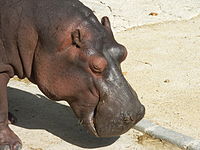
Hippopotamuses are one of the largest extant mammals in the world. They can live in the water, or go on land. Hippos are considered megafauna, but unlike all other African megafauna, hippos have adapted for a semi-aquatic life in freshwater lakes and rivers.
Because of their enormous size, hippopotamuses are difficult to weigh in the wild. Most estimates of the weight come from culling operations that were carried out in the 1960s. The average weights for adult males ranged between 1500–1800 kg (3,300–4,000 lbs). Females are smaller than their male counterparts, with average weights measuring between 1300–1,500 kg (2,900–3,300 lbs). Older males can get much larger, reaching at least 3,200 kg (7,100 lbs) and occasionally weighing 3636 kg (8000 lbs). Male hippos appear to continue growing throughout their lives; females reach a maximum weight at around age 25.
On the National Geographic Channel television program, "Dangerous Encounters with Brady Barr", Dr. Brady Barr measured the bite of an adult female hippo at 1,821 lb (826 kg). after abandoning an attempt to measure the bite of an adult male due to its aggressiveness.
Hippos average 3.5 meters (11 ft) long, 1.5 meters (5 ft) tall at the shoulder. The range of hippopotamus sizes overlaps with the range of the White Rhinoceros; use of different metrics makes it unclear which is the largest land animal after elephants. Even though they are bulky animals, hippopotamuses can run faster than a human on land. Estimates of their running speed vary from 30 km/h (18 mph) to 40 km/h (25 mph), or even 50 km/h (30 mph). The hippo can maintain these higher speeds for only a few hundred meters.
A hippo's lifespan is typically 40 to 50 years. Donna the Hippo, 56, is the oldest living hippo in captivity. She lives at the Mesker Park Zoo in Evansville, Indiana. The oldest hippo ever was called Tanga; she lived in Munich, Germany, and died in 1995 at the age of 61.
The eyes, ears, and nostrils of hippos are placed high on the roof of the skull. This allows them to be in the water with most of their body submerged in the waters and mud of tropical rivers to stay cool and prevent sunburn. Their general anatomical structure is an adaptation to their riparian lifestyle. Their skeletal structure is graviportal, adapted to carrying the animals' enormous weight. Hippopotamuses have legs that are small, relative to other megafauna, because the water in which they live reduces the weight burden. Like other aquatic mammals, the hippopotamus has very little hair.
For additional protection from the sun, their skin secretes a natural sunscreen substance which is red-colored. The secretion is sometimes referred to as "blood sweat," but is neither blood nor sweat. This secretion is initially colorless and turns red-orange within minutes, eventually becoming brown. Two distinct pigments have been identified in the secretions, one red and one orange. The two pigments are highly acidic compounds. They are known as red pigment hipposudoric acid and orange pigment norhipposudoric acid. The red pigment was found to inhibit the growth of disease-causing bacteria, lending credence to the theory that the secretion has an antibiotic effect. The light absorption of both pigments peaks in the ultraviolet range, creating a sunscreen effect. All hippos, even those with different diets secrete the pigments, so it does not appear that food is the source of the pigments. Instead, the animals may synthesize the pigments from precursors such as the amino acid tyrosine.
Distribution
Hippopotamus amphibius was widespread in North Africa and Europe before the last glaciation event, and it can live in colder climates provided the water does not freeze during winter. The species was common in Egypt's Nile region until historic times but has since been extirpated. Pliny the Elder writes that, in his time, the best location in Egypt for capturing this animal was in the Saite nome; the animal could still be found along the Damietta branch after the Arab Conquest in 639. Hippos are still found in the rivers and lakes of Uganda, Sudan, Somalia, Kenya, northern Democratic Republic of the Congo and Ethiopia, west through Ghana to Gambia, and also in Southern Africa (Botswana, Republic of South Africa, Zimbabwe, Zambia). A separate population exists in Tanzania and Mozambique.
Conservation status

Evidence through genetic analysis suggests that common hippos in Africa experienced a marked population expansion during or after the Pleistocene Epoch, attributed to an increase in water bodies at the end of the era. These findings have important conservation implications as Hippo populations across the continent are currently threatened by loss of access to fresh water. Hippos are also subject to unregulated or illegal poaching. In addition to addressing these common threats, the genetic diversity of hippos would need to be preserved to ensure the safety of the species. In May 2006 the hippopotamus was identified as a vulnerable species on the IUCN Red List drawn up by the World Conservation Union (IUCN), with an estimated population of between 125,000 and 150,000 hippos, a decline of between 7 percent and 20 percent since the IUCN's 1996 study.
The hippo population declined most dramatically in the Democratic Republic of the Congo. The population in Virunga National Park had dropped to 800 or 900 individuals from around 29,000 in the mid 1970s, raising concerns about the viability of that population. The decline is attributed to the disruptions caused by the Second Congo War. Poachers are believed to be former Hutu rebels, poorly paid Congolese soldiers, and local militia groups. Reasons for poaching include the belief that hippos are unintelligent, that they are a harm to society, and also for money. The sale of hippo meat is illegal, but black-market sales are difficult for WWF officers to track.
Invasive potential
In Colombia, Pablo Escobar maintained four hippos in a private menagerie at his residence in Hacienda Napoles, 100 km east of Medellín, after purchasing them in New Orleans. They were deemed too difficult to seize and move after the fall of Escobar, and hence left on the untended estate. By 2007, the animals had multiplied to 16 individuals and taken to roaming the area for food. Considered too difficult to move by local authorities, their fate remains uncertain as their presence is impeding development of the site.
Behaviour
Hippos spend most of their days wallowing in the water or the mud, with the other members of their pod. The water serves to keep their body temperature cool, and to keep their skin from drying out. With the exception of eating, most of hippopotamuses' lives—from childbirth, fighting with other hippos, and reproduction—occur in the water.
Hippos leave the water at dusk and travel inland, sometimes up to 8 kilometers (5 mi), to graze on short grass, their main source of food. They spend four to five hours grazing and can consume 68 kilograms (150 lb) of grass each night. Like almost any herbivore, they will consume many other plants if presented with them, but their diet in nature consists almost entirely of grass, with only minimal consumption of aquatic plants. Hippos have (rarely) been filmed eating carrion, usually close to the water. There are other reports of meat-eating, and even cannibalism and predation. The stomach anatomy of a hippo is not suited to carnivory, and meat-eating is likely caused by aberrant behaviour or nutritional stress.
The diet of hippos consists mostly of terrestrial grasses, but they spend most of their time in the water. Most of their defecation occurs in the water, creating allochthonous deposits of organic matter along the river beds. These deposits have an unclear ecological function. Because of their size and their habit of taking the same paths to feed, hippos can have a significant impact on the land they walk across, both by keeping the land clear of vegetation and depressing the ground. Over prolonged periods hippos can divert the paths of swamps and channels.
Interestingly, adult hippos can't actually swim and are not generally buoyant. When in deep water, they usually propel themselves by leaps, pushing off from the bottom. They move at speeds up to 8 km/h (5 mph) in water. However, young hippos are buoyant and more often move by swimming—propelling themselves with kicks of their back legs. Adult hippos typically resurface to breathe every 4–6 minutes. The young have to breathe every two to three minutes. The process of surfacing and breathing is automatic, and even a hippo sleeping underwater will rise and breathe without waking. A hippo closes its nostrils when it submerges.
Social life
Studying the interaction of male and female hippopotamuses has long been complicated by the fact that hippos are not sexually dimorphic and thus females and young males are almost indistinguishable in the field. Although hippos like to lie in close proximity to each other, they do not seem to form social bonds except between mothers and daughters, and are not social animals. The reason they huddle in close proximity is unknown.
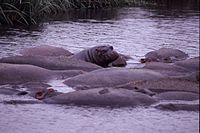
Hippopotamuses are territorial only in water, where a bull presides over a small stretch of river, on average 250 meters in length, and containing ten females. The largest pods can contain up to 100 hippos. Other bachelors are allowed in a bull's stretch, as long as they behave submissively toward the bull. The territories of hippos exist to establish mating rights. Within the pods, the hippos tend to segregate by gender. Bachelors will lounge near other bachelors, females with other females, and the bull on his own. When hippos emerge from the water to graze, they do so individually.
Hippopotamuses appear to communicate verbally, through grunts and bellows, and it is thought that they may practice echolocation, but the purpose of these vocalizations is currently unknown. Hippos have the unique ability to hold their head partially above the water and send out a cry that travels through both water and air; hippos above and under water will respond.
Reproduction
Female hippos reach sexual maturity at 5 to 6 years of age and have a gestation period of 8 months. A study of endocrine systems revealed that female hippopotamuses may begin puberty as early as 3 or 4 years of age. Males reach maturity at around 7.5 years.
A study of hippopotamus reproductive behaviour in Uganda showed that peak conceptions occurred during the end of the wet season in the summer, and peak births occurred toward the beginning of the wet season in late winter. This is because of the female's oestrous cycle; as with most large mammals, male hippopotamus spermatozoa is active year round. Studies of hippos in Zambia and South Africa also showed evidence of births occurring at the start of the wet season. After becoming pregnant, a female hippopotamus will typically not begin ovulation again for 17 months.

Mating occurs in the water with the female submerged for most of the encounter, her head emerging periodically to draw breath. Hippos are one of the few mammals that give birth under water, along with Cetaceans and Sirenians ( manatees and dugongs). Baby hippos are born underwater at a weight between 25 and 45 kg (60–110 lb) and an average length of around 127 cm (50 in) and must swim to the surface to take their first breath. A mother typically gives birth to only one hippo, although twins occur at an unknown ratio. The young often rest on their mothers' backs when in water that is too deep for them, and they swim underwater to suckle. They also will suckle on land when the mother leaves the water. Weaning starts between six and eight months after birth and most calves are fully weaned after a year.
Hippos are considered K-strategists, meaning that they favour quality over quantity in their reproduction. K-selection is the norm for large animals that produce few young at each birth.
Aggression
Hippopotami are very violent tempered animals. Adult hippos are hostile toward crocodiles, which often live in the same pools and rivers as hippos. This is especially so when hippo calves are around. Hippos have been known to be very aggressive towards humans, and it is often claimed that hippos are the deadliest animal in Africa; however, according to Smithsonian Magazine, while the animal is very dangerous, reliable statistics for this are unavailable.
To mark territory, hippos spin their tails while defecating to distribute their excrement over the greatest possible area. Hippos also urinate backwards (are retromingent), likely for the same reason.
Hippos rarely kill each other, even in territorial challenges. Usually a territorial bull and a challenging bachelor will stop fighting when it is clear that one hippo is stronger. When hippos become overpopulated, or when a habitat starts to shrink, bulls will sometimes attempt to kill infants; sometimes female hippos will kill the bulls to protect their infants, but neither behaviour is common under normal conditions.
Hippos and humans

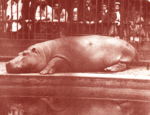
The earliest evidence of human interaction with hippos comes from rock paintings and engravings in the mountains of the central Sahara. One such drawing, dated 4,000–5,000 years ago near Djanet in the Tassili n'Ajjer Mountains, shows hippos being hunted. Hippos were also well-known to the ancient Egyptians, where the hippo was recognized as a ferocious denizen of the Nile. In Egyptian mythology, the hippopotamus-headed Tawaret, was a goddess of protection in pregnancy and childbirth, because ancient Egyptians recognized the protective nature of a female hippopotamus toward her young.
The hippopotamus has been known to historians since Classical antiquity. The Greek historian Herodotus described the hippopotamus in The Histories (written circa 440 BC) and the Roman Historian Pliny the Elder wrote about the hippopotamus in his encyclopedia Naturalis Historia (written circa 77 AD).
Hippos in zoos
Hippopotamuses have long been popular zoo animals. The first zoo hippo in modern history was Obaysch who arrived at the London Zoo on May 25, 1850, where he attracted up to 10,000 visitors a day and inspired a popular song, the Hippopotamus Polka. Hippos have remained popular zoo animals since Obaysch, and generally breed well in captivity. Their birth rates are lower than in the wild, but this is attributed to zoos not wanting to breed as many hippos as possible, since hippos are large and relatively expensive animals to maintain.
Most hippos in zoos were born in captivity. There are enough hippos in the international zoo system, that introducing further animals from the wild will be unnecessary if zoos cooperate to maintain the genetic diversity of the breeding stock.
Like many zoo animals, hippos were traditionally displayed in concrete exhibits. In the case of hippos, they usually had a pool of water and patch of grass. In the 1980s, zoo designers increasingly designed exhibits that reflected the animals' native habitats. The best known of these, the Toledo Zoo Hippoquarium, features a 360,000 gallon pool for hippos. In 1987, researchers were able to tape, for the first time, an underwater birth (as in the wild) at the Toledo Zoo. The exhibit was so popular that the hippos became the logo of the Toledo Zoo.
Cultural depictions
The Hippopotami was known to the Greeks and Romans as the Beast of the Nile. A red hippo also represented the Ancient Egyptian god Set; the thigh is the 'phallic leg of set' symbolic of virility. Set's consort Tawaret was also seen as part hippo. The Behemoth from the Book of Job, 40:15-24 is also thought to be based on a hippo.
Ever since Obaysch inspired the Hippopotamus Polka, hippos have been popular animals in western culture for their rotund appearance that many consider comical. Stories of hippos like Huberta who became a celebrity in South Africa in the 1930s for trekking across the country; or the tale of Owen and Mzee, a hippo and tortoise who developed an intimate bond; have amused people who have bought hippo books, merchandise, and many a stuffed hippo toy. Hippos were mentioned in the novelty Christmas song " I Want a Hippopotamus for Christmas" that became a hit for child star Gayla Peevey in 1953. They even inspired a popular board game, Hungry Hungry Hippos.
"The Hippopotamus Song" (aka "Mud, Mud, Glorious Mud!") by Flanders and Swann is noted for its often-strained rhymes for "hippopotamus" ("gazed at the bottom as..."; "The hippopot-A-mus was no ignoramus..."), "hippopotami" ("I wonder, now, what am I..."; "A regular army of hippopot-ah-mi...) and even the implied feminine "hippopotama" ("...as she hadn't got a Ma...").
Hippos have been popular cartoon characters, where their roly-poly frame is used for humorous effect. In the Disney film Fantasia featured a ballerina hippopotamus dancing to the opera, La Gioconda. Other cartoon hippos have included Hanna-Barbera's Peter Potamus, the book and TV series George and Martha, and Flavio and Marita on the Animaniacs. The hippopotamus characters "Happy Hippos" have been created 1988 by the french designer Andre Roche based in Munich, to be hidden in the "Kinder Surprise egg" of the Italian chocolate company Ferrero SpA. These characters were not placid like real hippos but rather cute and lively, and had such a success that they reappeared several times in different products of this company in the following years, increasing their popularity worldwide each time. The Nintendo company published in the years 2001 and 2007 Game Boys adventures of them.
In the game of chess, the hippopotamus lends its name to the Hippopotamus Defence, a solid if unadventurous opening system.


